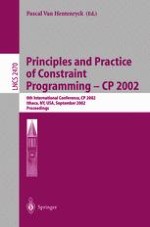2002 | Buch
Principles and Practice of Constraint Programming - CP 2002
8th International Conference, CP 2002 Ithaca, NY, USA, September 9–13, 2002 Proceedings
herausgegeben von: Pascal Van Hentenryck
Verlag: Springer Berlin Heidelberg
Buchreihe : Lecture Notes in Computer Science
Enthalten in: Professional Book Archive
